| کد مقاله | کد نشریه | سال انتشار | مقاله انگلیسی | نسخه تمام متن |
|---|---|---|---|---|
| 4375624 | 1617428 | 2016 | 15 صفحه PDF | دانلود رایگان |
• The need for multispecies models in fisheries management is highlighted.
• Predation is the main factor regulating the biomass of the prey groups.
• Target species are best managed through the protection of adults.
• A ban on discarding does not appear to significantly affect predators or prey.
Reduction of complexity and capacity to evaluate management strategies are important considerations when modelling complex ecosystems. Models of Intermediate Complexity for Ecosystem assessments (MICE) achieve this by representing interactions among a restricted number of crucial species in the ecosystem considered. MICE applications are question-driven, heavily dependent on available data for conditioning and aimed at addressing tactical issues. Here we present the development of a MICE for the central Adriatic Sea. This area is important ecologically and economically because it supports a commercial stock of Norway lobster (Nephrops norvegicus), and a nursery ground for European hake (Merluccius merluccius), as well as being subjected to high levels of fishing pressure. Here, Italian and Croatian bottom trawl fisheries mainly target Norway lobster while impacting juvenile hake. Single-species stock assessments for the target species indicate fluctuating trends between 2006 and 2013, as do the survey biomass trends of most of their prey, underlining the need for a multispecies management plan. The diet of the target species were examined and prey items partitioned into four groups. Consumption of prey groups by predators was modelled using a Holling Type II functional response. A modified biomass dynamic model was used to represent the prey dynamics, projecting them into the future for 10 years (2013–2022) and testing different management strategies, including a discard ban. The most effective management option was the protection of larger individuals, which led to a clear improvement in the stock abundance and spawning stock biomass of both hake and Norway lobster without significant adverse effects on their prey. The discard ban scenario appeared to have knock-on effects on both predators and some of their prey.
Journal: Ecological Modelling - Volume 319, 10 January 2016, Pages 218–232
